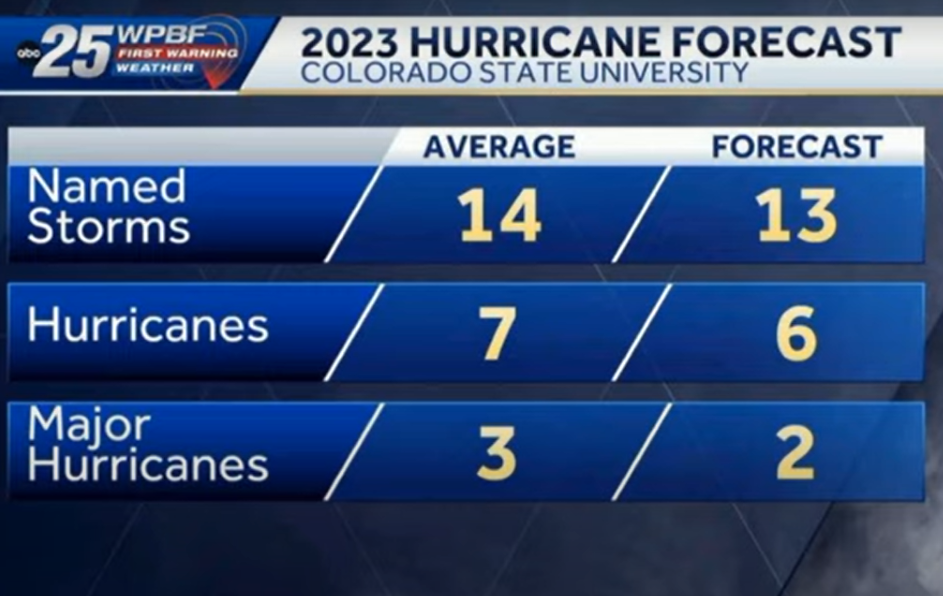FORT COLLINS — The likely development of El Niño should bring a “slightly below-average” Atlantic hurricane season, top forecasters announced Thursday at a hurricane conference in Texas. But the forecast also notes a high level of uncertainty.
Meteorologists from Colorado State University predict a total of 13 tropical storms will form, of which six will become hurricanes. A tropical storm becomes a hurricane when its sustained winds reach 74 mph.
A typical year averages about 14 tropical storms, with seven spinning into hurricanes, based on weather records that date from 1991 to 2020.
This forecast covers storms that form in the Atlantic basin, which includes the Caribbean Sea and the Gulf of Mexico.
What role does El Niño play?
Strong westerly winds spurred on by El Niño – a natural climate pattern marked by warmer-than-average Pacific Ocean water – tend to prevent nascent Atlantic storms from developing. This occurs because those increased upper-level winds can tear apart hurricanes as they try to form.
In its latest forecast released Thursday, the Climate Prediction Center issued an “El Nino watch,” noting that El Niño could appear as soon as May, with a 62% chance it forms at some point between May and July of this year.
How many major hurricanes?
Phil Klotzbach, Colorado State meteorologist and lead author of the report, said that of the six predicted hurricanes, two should be major hurricanes – category 3, 4 or 5 – with sustained wind speeds of 111 mph or greater.

More uncertainty than normal
Given the conflicting signals between a potentially robust El Niño and an unusually warm tropical and subtropical Atlantic, the Colorado State team stresses that there is more uncertainty than normal with this outlook.
“Our analog seasons exhibited a wide range of outcomes, from below-normal seasons to hyperactive seasons,” said Klotzbach, a research scientist at CSU’s Department of Atmospheric Science. “This highlights the large uncertainty that exists with this outlook.”
Colorado State University meteorologist Michael Bell, a co-author of the forecast, cautioned coastal residents to take precautions whatever the forecast. “It takes only one storm near you to make this an active season for you,” Bell said.
What about landfall hurricanes?
The report also includes the probability of major hurricanes making landfall in the U.S.:
- 44% for the entire U.S. coastline (average from 1880 to 2020 is 43%)
- 22% for the East Coast, including the Florida peninsula (average from 1880 to 2020 is 21%)
- 28% for the Gulf Coast from the Florida Panhandle westward to Brownsville, Texas (average from 1880 to 2020 is 27%)
Who looks at this forecast?
The Atlantic hurricane season runs from June 1 to Nov. 30, though storms sometimes form outside those dates.
Insurance companies, emergency managers and the media use the forecasts to prepare Americans for the year’s hurricane threat. The team’s annual predictions provide a best estimate of activity, not an exact measure, according to Colorado State.
The university, under the direction of meteorologist William Gray, was the first group to predict seasonal hurricane activity in the mid-1980s. Gray died in 2016.
What do other forecasters say?
Meteorologists at AccuWeather, in a forecast released last week, predicted that 11 to15 named tropical storms would develop in the Atlantic basin in 2023, of which four to eight would be hurricanes. Federal scientists from the National Oceanic and Atmospheric Administration will release their forecast in May.
According to the National Hurricane Center, the first named storm of the Atlantic hurricane season will be Arlene, followed by:
- Bret
- Cindy
- Don
- Emily
- Franklin
- Gert
- Harold
What happened last year?
According to Colorado State University, the 2022 hurricane season will be most remembered for its two major hurricanes: Fiona and Ian. Fiona brought devastating flooding to Puerto Rico before causing significant storm surge, wind and rain damage in the Atlantic Provinces of Canada as a post-tropical cyclone.



